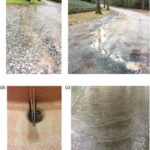低コストで地球上に豊富に存在する原料を利用した新しいグリッドエネルギー貯蔵ソリューションを開発。 Low-cost, Earth-abundant raw materials power a new grid energy storage solution
2023-02-07 パシフィック・ノースウェスト国立研究所(PNNL)
◆「この新しい溶融塩電池は、従来の高温ナトリウム電池よりもはるかに高速に充放電でき、低温で動作し、優れたエネルギー貯蔵容量を維持できる可能性を示しました」と、PNNLの材料科学者で研究責任者のGuosheng Liは述べています。「この新しいナトリウムベースの化学物質で、より地球に豊富な材料を使用しながら、市販の高温ナトリウム電池技術よりも100℃以上低い温度で、同様の性能を得ることができました。
◆この新しいナトリウム系溶融塩電池は、2つの異なる反応を利用しています。研究チームは以前、中性溶融塩反応について報告しています。今回の発見では、この中性溶融塩がさらに反応し、酸性の溶融塩になることが示された。重要なのは、この2つ目の酸性の反応機構によって、電池の容量が増大することである。具体的には、大電流で345回の充放電を行った後、この酸性反応機構はピーク時の充電容量の82.8パーセントを維持した。
◆実際、PNNLの研究者たちは、米国に拠点を置く再生可能エネルギーのパイオニア、ネクセリス社の同僚たちと協力して、電池を組み立て、テストを行った。ネクセリス社は、新事業のアデナ・パワー社を通じて、特許を持つナトリウムベースの固体電解質をPNNLに提供し、電池の性能をテストした。この重要な電池部品により、充電時にナトリウムイオンが電池のマイナス側(負極)からプラス側(正極)へ移動することができます。
◆スプリンクルは、この電池の新しい柔軟な設計を開発したチームの一員で、電池も従来のチューブ状のものから、コインサイズの電池からより大きなグリッドスケールの実証サイズに技術が発展するにつれて、より簡単に積み重ねたり拡張したりできるフラットでスケーラブルなものへと変化させました。さらに重要なのは、この平板なセル設計により、正極を厚くするだけで、セル容量を増やすことができることだ。今回、研究者らはこれを利用して、実験室条件下で28.2時間持続放電できる3重容量セルを実証した。
◆研究チームは放電時間を延ばすための更なる改良に注力しており、これにより再生可能な電力源をより多く取り入れるためのグリッドの柔軟性が大幅に改善される可能性があります。
◆また、PNNLの電池専門家で研究の共著者であるDavid Reed氏は、「この電池は低温で作動するため、従来の高温ナトリウム電池のように複雑で高価な部品やプロセスを必要とせず、安価な電池材料で製造することができます」と述べています。「この新しいシステムは、材料と製造に関する予想されるコスト目標を達成できれば、蓄電量を大幅に増やすことができます」とも述べています。
◆研究の一環として、研究者らは、安価な原材料をベースにしたナトリウム・アルミニウム電池の設計では、活物質コストが1kWhあたりわずか7.02ドルになると推定している。最適化と実用的なエネルギー密度の向上により、このコストはさらに下がることが予想される。この低コストでグリッドスケールの蓄電技術が実現すれば、風力や太陽光などの断続的な自然エネルギーが、よりダイナミックに電力網に貢献できるようになる可能性があります。
<関連情報>
- https://www.pnnl.gov/news-media/new-sodium-aluminum-battery-aims-integrate-renewables-grid-resiliency
- https://www.sciencedirect.com/science/article/pii/S2405829723000107?via%3Dihub
低コスト・長寿命のNa-Al電池を実現するNaCl-AlCl3相図の解明に成功 Unlocking the NaCl-AlCl3 phase diagram for low-cost, long-duration Na-Al batteries
J. Mark Weller, Minyuan M. Li, Evgueni Polikarpov, Kee Sung Han, Neil Kidner, Anant Patel, Mai Nguyen, Meghan Stout, Michael Gossett, Keeyoung Jung, David M. Reed, Vincent L. Sprenkle, Guosheng Li
Energy Storage Materials Available online: 7 January 2023
DOI:https://doi.org/10.1016/j.ensm.2023.01.009

Highlights
- •Extended sodium chloroaluminate chemistry from neutral (NaAlCl4) to acidic (NaAl2Cl7) catholyte to increase specific capacity/energy.
- •Demonstrated excellent reversibility of acidic chloroaluminate chemistry with purely inorganic catholyte.
- •Raman and NMR spectroscopy confirms conversion to NaAl2Cl7 at end of charge.
- •Liquid-solid reaction mechanism at the cathode allows higher areal capacity, suitable for long-duration energy storage.
- •Based on inexpensive raw materials ($7.02 kWh−1): promising for low-cost grid-scale storage to enable intermittent renewables.
Abstract
Sodium and aluminum are a natural combination of inexpensive, abundant elements as a redox pair for battery energy storage. Recent explorations pairing a sodium anode and aluminum cathode have demonstrated reversible, energy dense Na-Al cells with excellent rate capability using the electrochemical reaction between a molten Na anode and a NaAlCl4/Al cathode. In this work, the NaAlCl4/Al cathode is extended beyond the neutral NaAlCl4 composition by unlocking the NaCl-AlCl3 phase diagram to explore the extra accessible capacity hidden in acidic chloroaluminate melts up to and beyond the composition NaAl2Cl7. This enables higher specific capacity and average discharge voltages than previous Na-Al batteries, utilizing two distinct cell reaction mechanisms in one battery. Fundamental aspects of the NaAlCl4-NaAl2Cl7 reaction chemistry are investigated, and Na-metal/chloroaluminate batteries with excellent reversibility and areal capacity are demonstrated. Increasing the voltage window of the chloroaluminate Na-Al battery takes advantage of the higher voltage (∼ 2 V vs ∼1.6 V for neutral NaAlCl4) contributed by the acidic chloroaluminate cathode reaction, unlocking an additional specific energy of ∼119 Wh kg−1 by utilizing the conversion of NaAlCl4 to NaAl2Cl7, which adds to the neutral melt reaction between NaAlCl4/Al and Na (∼493 Wh kg−1 theoretical). By significantly increasing the cathode thickness and therefore accessible areal capacity up to 131.7 mAh cm−2, a discharge duration of 28.2 h is achieved with an estimated raw active materials cost of $7.02 kWh−1. These metrics show the great potential of this unlocked chloroaluminate battery for future low-cost, long-duration electrochemical energy storage.



